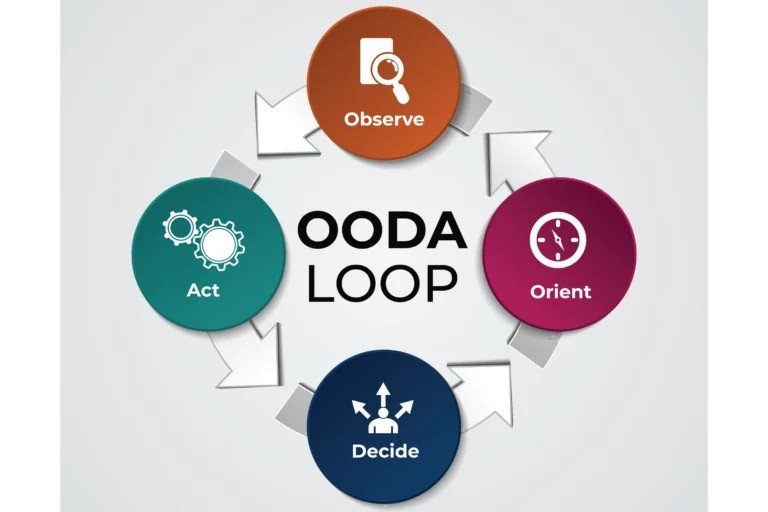Make Quality Decisions in Your Business with the OODA Loop
May 23, 2024
Being a business owner means you are the one to make the call for the most important decisions for the company and that can be a lot to handle and put a lot of pressure on you. It’s a common scenario in the fast-paced world of business, so you’re not alone. But what if I told you there’s a method that can sharpen your decision-making skills, allowing you to act more decisively and swiftly? Enter the OODA Loop, a concept originally developed for combat but incredibly effective in the business arena as well.
I cover this topic in depth on my Soar Higher Podcast. Check out the episode here. But before you check that out, let me walk you through how the OODA Loop can transform your decision-making process and keep you several steps ahead of the competition.
Origins of the OODA Loop
The OODA Loop was developed by military strategist John Boyd during his time in the air force. Boyd created this strategic tool to help pilots win aerial dogfights and missions by making rapid, effective decisions under extreme pressure. The acronym OODA stands for Observe, Orient, Decide, and Act, and it’s designed to foster quick thinking and adaptability—qualities just as crucial in the business world as they are in aerial combat.
Describing Each Part of the OODA Loop
Observe
At the core of the OODA Loop is observation. It’s all about gathering as much information as possible from your environment. In business, this means keeping a keen eye on market trends, customer feedback, and internal business metrics. Constant vigilance helps you spot opportunities and threats early on.
Orient
This is where your gathered data comes to life. In the Orient phase, you interpret the information based on your previous experience, your company’s capabilities, and the current operational context. This phase is critical because it shapes the options available to you and can often be the bottleneck in speeding up decision-making.
Decide
Here’s where you choose your course of action. Based on your orientation, you’ll decide the best path forward. This step doesn’t need to be overly complicated; it’s about making the best decision possible with the information at hand, not the perfect decision.
Act
Finally, you implement the decision. The Act stage closes the loop, but it also reopens it. Once you act, you start observing the results of your decision, leading back to the first stage of the next loop. This cyclical process ensures continuous improvement and adaptation.
Internal vs. External OODA Loop
The OODA Loop’s effectiveness extends beyond its general approach, adapting distinctly to both internal operations within a company and external interactions with the market and competition. Understanding how to leverage both aspects of the OODA Loop can provide a significant strategic advantage in business management.
Internal OODA Loop
Internally, the OODA Loop focuses on improving your organization’s operational efficiency and responsiveness. It’s about fine-tuning your processes and decision-making within the team. For instance, consider a scenario where your customer service department is facing repeated issues with response times. By observing this trend through customer feedback and performance metrics, you orient your strategy by identifying bottlenecks in the process or gaps in staff training. Decisions might involve implementing new customer relationship management (CRM) software or restructuring the team to better manage workload. Acting on these decisions, you then monitor the new system’s effectiveness, ready to loop back to observation and adjust as necessary.
External OODA Loop
Externally, the OODA Loop helps you stay ahead of industry trends and competitive moves. Here, observation involves market research and competitor analysis. Orientation might require you to reassess your business’s strengths and weaknesses in light of emerging trends or new competitor strategies. The decision phase could involve launching a new product line or adjusting marketing strategies to address changes in consumer preferences. The action taken will then be closely monitored to gauge its impact against competitors, with the loop beginning anew based on these observations.
Full Example of a Business Owner Using the OODA Loop
Let’s take a look at a practical example with a coffee shop owner. Their business, like many others, was hit hard by changes in consumer behavior due to local economic shifts. Here’s how they successfully use the OODA Loop to navigate her challenges:
Observe: First, they notice a gradual decrease in foot traffic, which correlates with an increase in local remote work due to new corporate policies. Her observation extends to noting the rise of home brewing trends and online coffee sales.
Orient: Then they analyze the observations against the coffee shop’s current capabilities, such as their in-house brewing expertise and their small online presence. She also considers the interest in sustainable practices and local community engagement.
Decide: They decide to shift part of the business model to include online sales of specialty brew kits. Additionally, they plan to host weekend coffee brewing workshops to engage the community and create an experiential offering that leverages their team’s expertise.
Act: They then implement the online sales component by setting up an e-commerce platform and using social media to promote their brewing workshops. They collaborate with local influencers to boost their marketing efforts.
Re-OODA: After launching the online store and hosting several workshops, The company revisits their OODA Loop. They observe the outcomes through sales data and workshop attendance. Noticing positive feedback, they orient their future decisions to enhance these offerings, considering new workshop themes and expanding their online product range.
Through this example, we see how the OODA Loop helped the coffee shop adapt to external market changes while optimizing its internal operations. By continuously moving through each phase of the OODA Loop, they keep the business agile and responsive to both their immediate operational needs and broader market dynamics. This strategic agility is key to maintaining competitiveness and sustainability in a rapidly changing business environment.
Using the OODA Loop in Business
Implementing the OODA Loop in your daily operations can drastically improve your strategic decisions. It’s about creating a culture where fast decision-making is supported and encouraged. For instance, in marketing, the OODA Loop can help you quickly adjust campaigns based on real-time customer feedback, keeping your strategies fresh and relevant.
Enhancing Team Dynamics with the OODA Loop
Training your team to use the OODA Loop can lead to better communication and more cohesive team actions as well. When everyone understands how to observe, orient, decide, and act effectively, it reduces confusion and increases efficiency.
Technology and the OODA Loop
Technology plays a huge role in optimizing the OODA Loop. Tools like real-time data analytics and AI can automate the observation and orientation phases, allowing you and your team to focus on decision-making and action. This can be particularly useful in areas like customer service and inventory management.
Mastering the OODA Loop doesn’t just keep you ahead in business; it transforms you into a more effective leader. By adopting this loop, you can make your company more agile and responsive, qualities that are indispensable in today’s fast-paced market. Remember, the goal is not to get caught up in seeking perfect decisions but rather in making good decisions quickly and refining them along the way.
Why not start today? Take a moment to review your current decision-making processes. Are they as swift and effective as they could be? Consider how integrating the OODA Loop could enhance not only your decisions but also your overall business dynamics. And don’t forget to tune into our podcast for more insightful tips on using this powerful strategy in your everyday business practices. If you want to get started and need some help, you can give us a call too.



